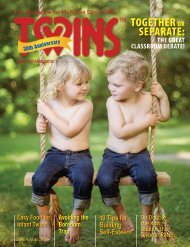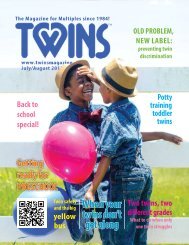2004 Guide To The First Year with Twins
In this edition: Are they twins Back to Sleep Breast feeding Your Twins Does zygosity matter Early Arrivals Getting out and about Getting Started a Basic Layette HELP! I Need Somebody Introducing Solid Foods It's Child's Play Juggling Act…one Mom's story Nicu Primer Protecting Your Child From RSV Pumping Primer SLEEPING Through the NIGHT Teething Times two The best-laid plans The early days The Road to Independece The Twin Bond Weaning Awareness Welcome Home What About Me
In this edition:
Are they twins
Back to Sleep
Breast feeding Your Twins
Does zygosity matter
Early Arrivals
Getting out and about
Getting Started a Basic Layette
HELP! I Need Somebody
Introducing Solid Foods
It's Child's Play
Juggling Act…one Mom's story
Nicu Primer
Protecting Your Child From RSV
Pumping Primer
SLEEPING Through the NIGHT
Teething Times two
The best-laid plans
The early days
The Road to Independece
The Twin Bond
Weaning Awareness
Welcome Home
What About Me
Create successful ePaper yourself
Turn your PDF publications into a flip-book with our unique Google optimized e-Paper software.
Newborn NOTES
Freeze the
season
Blend a batch of
fresh-cooked veggies for your
twins. Freeze the leftovers in ice
cube trays or small muffin tins. When frozen, remove
the individual portions and store in plastic baggies.
Weaning babies from the breast or bottle requires planning
and patience and it must be gradual. Once you determine
when to start weaning, think about how to do it. Your
babies can go straight from the breast to a bottle then move on to a
cup or they might move right from the breast to a cup with ease.
Bottle-fed babies, of course, go straight to a cup.
When weaning babies from the breast, multiples may wean individually
or at the same time.“There is no natural rule specifying that
complete weaning must occur by a designated age,” explains Karen
Kerkhoff Gromada, author of the newly revised book Mothering
Multiples (La Leche League International). The American Academy
of Pediatrics recommends “that breastfeeding continue for at least 12
months and thereafter for as long as mutually desired.”
There are several ways to approach weaning breastfed multiples.
“Baby-led weaning” occurs when the mother is breastfeeding
based on her babies’ individual cues and works best for fraternals
or multiples
who have different
temperaments and
needs. “The mother
doesn’t offer breastfeeding
as a distraction
or a way to quiet
the baby or toddler,
but she doesn’t refuse
the child when he
Weaning indicates the need to
breastfeed,” Karen
Awareness
emphasizes.
“Mother-guided,
babies-led weaning” takes place when the mother “begins to set
flexible limits on certain aspects of breastfeeding,” Gromada continues.
This can include breastfeeding one at a time, only at
home, in a quiet room and/or in a certain position such as lying
down.
“Partial weaning” may be initiated by a mother who wants “to
decrease the number of feedings while meeting the needs of her
babies or toddlers to some extent,” Karen says. Some approaches
used in “mother-guided, babies-led weaning” can be used, as well
as limiting the duration of the feeding by slowly counting to 20.
Mom can limit the number of feedings to the one or two per day
that appear to be most important to the children.
Weaning breastfed or bottle-fed multiples is different from
weaning singletons and takes twice as much reassurance and support
from caregivers.
Introducing Solid Foods
Most physicians recommend introducing solid foods
about six months after birth. “Infants are geared to suck
and swallow. At about 6 months of age, the configuration
of the face evolves to allow efficient eating and chewing.
There is no nutritional advantage to giving solids early. Breast
milk provides 100% of the essential nutrients a baby needs,
including iron in a particularly digestible form. The same can be
said for fortified formulas,” explains Steven J. Sainsbury, M.D.
In addition, certain skills are essential for eating solids: Your
babies must sit well when supported, have good head control and
be able to take food into the backs of their mouths and swallow.
Rice cereal is a good first solid. After you give the regular feeding
of breast milk or formula, place your babies in a sitting position
and offer them the cereal with a spoon. The texture will seem
strange to them at first. After they master a few tablespoons once
a day, add a second cereal feeding. When you are feeding about a
half cup of cereal daily, you can begin to add other solid foods.
Strained solid foods should be introduced one at a time. This
will allow you to judge any reactions to a specific food. Fruits and
vegetables are easiest to digest. When your babies become more
proficient at chewing, add foods with more texture. To encourage
good eating habits, offer a variety of foods. If you get a less than
enthusiastic reaction to a particular food, try offering it again at
a later time.
34 GUIDE TO THE FIRST YEAR To subscribe to TWINS call 1-888-55-TWINS or go to www.TwinsMagazine.com

















